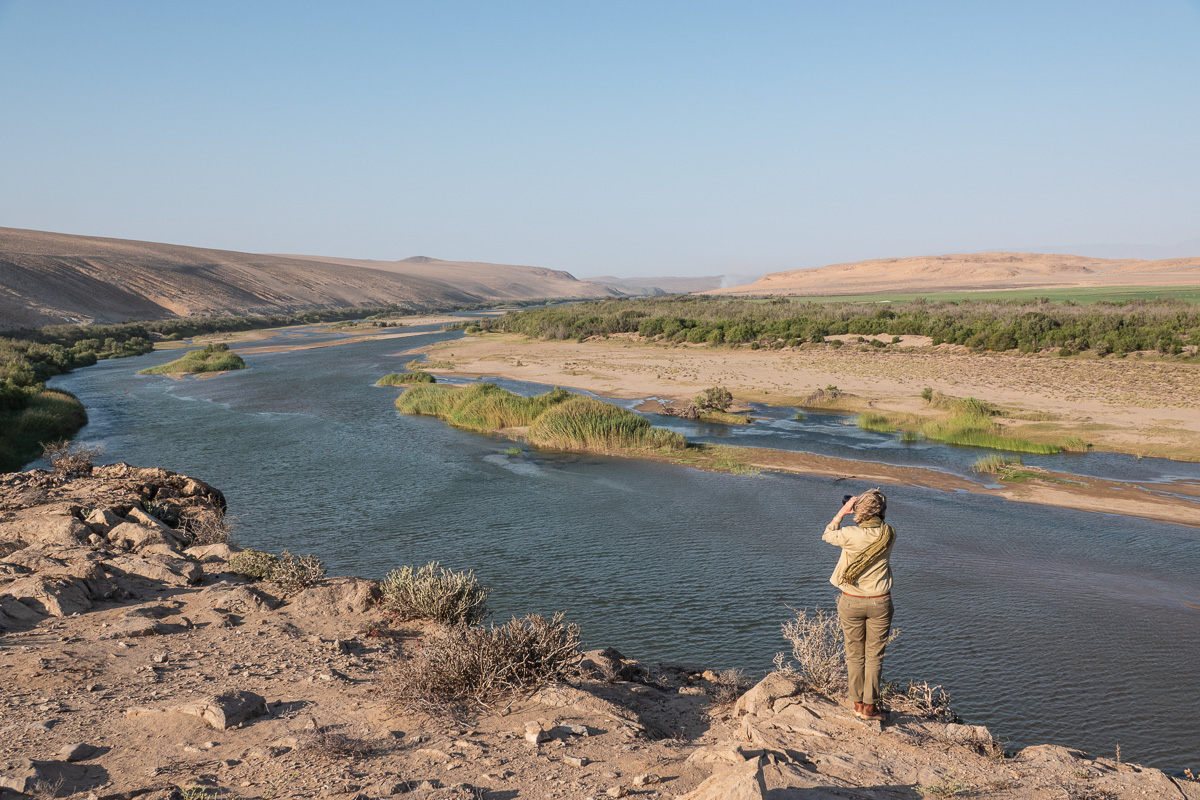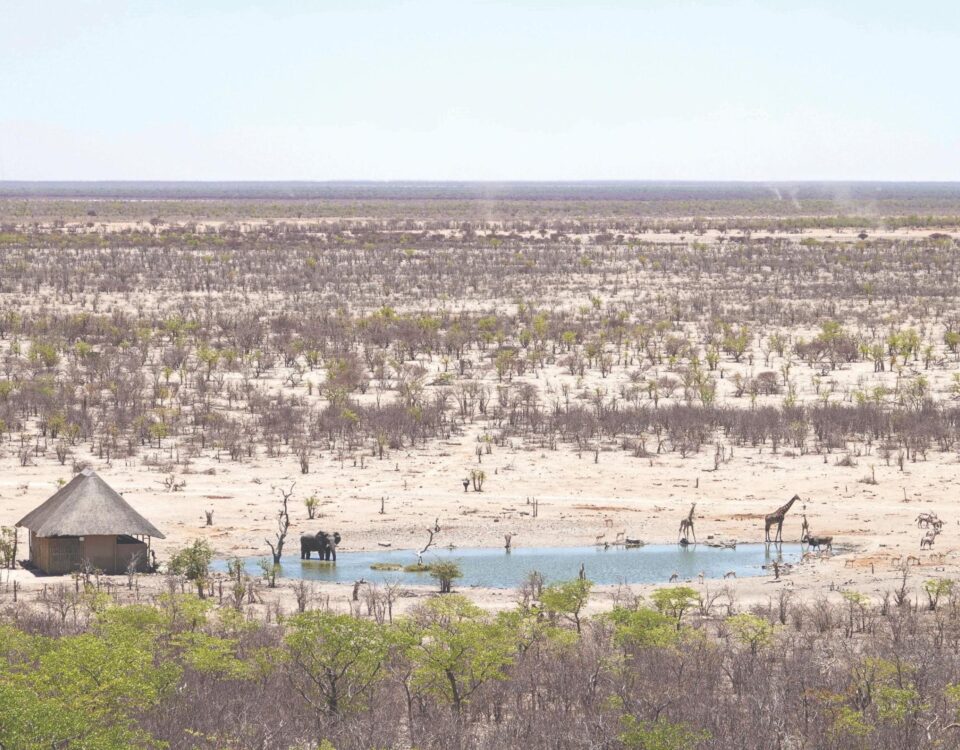
AM WEINBERG
January 13, 2020
Oranjemund desert transformation
January 14, 2020Text and Photographs Elzanne McCulloch
There’s a swing chair on our porch and an outside shower. The plants next to our front door are indigenous. There’s a TV screen in our room that live-streams the waterhole, and there is a visitor centre filled to the brim with data, research, history. I could get lost in there. Information and innovation for the good of nature. The staff smiling and oh so helpful. A long bench couch lines the entire area facing a waterhole frequented by wildlife, putting on a show. It’s authentic safari and every detail has been carefully considered. Even the glass that surrounds a lovely sitting area adjacent to the bar is customised with an anti-reflective UV coating so that birds don’t fly into it. Everything has been thought of. Consciousness is the new luxury. And the new Anderssons at Ongava is as conscious as they come.
We take a late afternoon drive into the private nature reserve. Photographing lions as they laze away the remaining day in the last rays of sunshine. Muzzles still tinged red from a meal. Black rhino foraging through the bushland. For the first time I see giraffe lying down. A peculiar sight. The moon rises behind the mopane trees in sync with the setting sun on the western edge. A choreographed symphony. We sip on our gin and tonics and watch the blood-red sun dip behind the mountains some ways off. A white rhino and her calf cross the road in front of another safari vehicle. The guide and his guests are making their way back to camp for an evening of indulgent meals and enthralling conversation around a fire. When the lions visit the waterhole that night we hear their low bass growl first. Our meals abandoned for a quick walk down the long bunker-like corridor that leads to the hide. The photographic hide is at the very edge of the waterhole and the sound of the lions drinking while we sit in the silent darkness thrills.
The chill of the early morning air helps me wake up (more than coffee ever could) as we head into Etosha National Park. Etosha, one of Africa’s most prolific and popular national parks, is Ongava’s neighbour. Our game viewer meanders through the “great white place” and we are treated to sightings of elephant tugging at nebrowni bushes with bright yellow flowers. Two honey badgers scrounge around in the bare earth for something to eat. Wildlife hustles for survival during this time of extreme drought. The worst we’ve seen in 100 years, or so I’m told.
Back at the lodge a lioness prowls along the shadowy edges of a bush just beyond the waterhole. Eyes keenly focussed on the two warthogs quenching their thirst. My eyes intently watch her small twitching movements through the telescope set up just beyond the bar area. A cold beer on the table to my left. Condensation running down the smooth glass. The sun is high. It’s hot even though it’s technically still winter. The earth is dry and the bush is grey. And it’s so hot. Not her normal hunting time. Yet, still she sits in the shadows cast by the dry and barren branches of a tree and watches the warthogs. Powerful muscles twitching. Instinct telling her to stay as still as possible, but anticipation betraying her. She’s still young. She slowly makes her way a few metres forward. Sticking to those shadows. She peers from behind the trunk of a bare tree. Muscles still twitching. One of the warthogs stops drinking and looks up. Whether he’s done or has sensed some unwanted energy in the air is unclear, but he glances around surreptitiously. Nervous. His friend is oblivious. It is this disregard that will be his downfall. She’s waited long enough now. Her twitching muscles tense, and as the nervous one starts to trot away she makes her move. Dust. A squeal. More dust. The nervous one flies across our view and out of sight. He’s catapulted himself over the electrified fencing that keeps the elephants away from the pool and has found sanctuary among the lodge’s buildings. His ignorant friend is not as lucky. She’s caught up with him just beyond our view. In the very same dry and barren bush she previously used as cover.
The world is changing and we have to adapt right along with it. We’re told not to use straws anymore and to have less children. We buy things with less packaging and share the right posts on our Facebook pages. We like those Greta Thunberg videos without really listening to her speech all the way through. We’re changing the world, we think.
“The world is changing and we have to adapt right along with it.”
But what are we actually doing? Doing physically, tangibly?
I mull over this at lunch with Dr John Mendlesohn, the director of the Ongava Research Centre. We talk about books and opinions. He tells me that they are pondering where to start with their research here. He wants to look at the bigger picture. How the natural world interacts and the way in which every link in the chain affects the next. Humans are a link in that chain, I think. Specialised and specific research topics are important, but who is looking at that big picture? We talk about the future of conservation. Landscape level. The story that needs to be told, and he asks me what I think that should be. I’m smiling, because I spent the last day-and-a-half marvelling at the new Anderssons. Driving around Ongava Game Reserve. Poring over the information at the Visitor Centre, all the while knowing that a group of researchers was busy setting up camp at the research base right next door. They will try to change the world. Or at least the way in which we approach saving it. This is the future of conservation. Like-minded individuals tackling big problems. A tourism institution that places more emphasis on how its operations are affecting its natural surroundings than its bottom line. Nature first. Consciousness.
The luxury is there. The rooms are gorgeous and all your needs are catered for. Activities to keep you engaged. You will enjoy every bite of every meal and there will always be ice in your drink. You will not get off a game viewing vehicle with an ounce of disappointment. Yet, above all, you will feel something. A sense of consciousness woven into the fabric of this place. You might not notice the signs, but you will feel the thought that went into creating it. Consciousness is the new luxury.
This article was first published in the Summer 2019/20 issue of Travel News Namibia.


